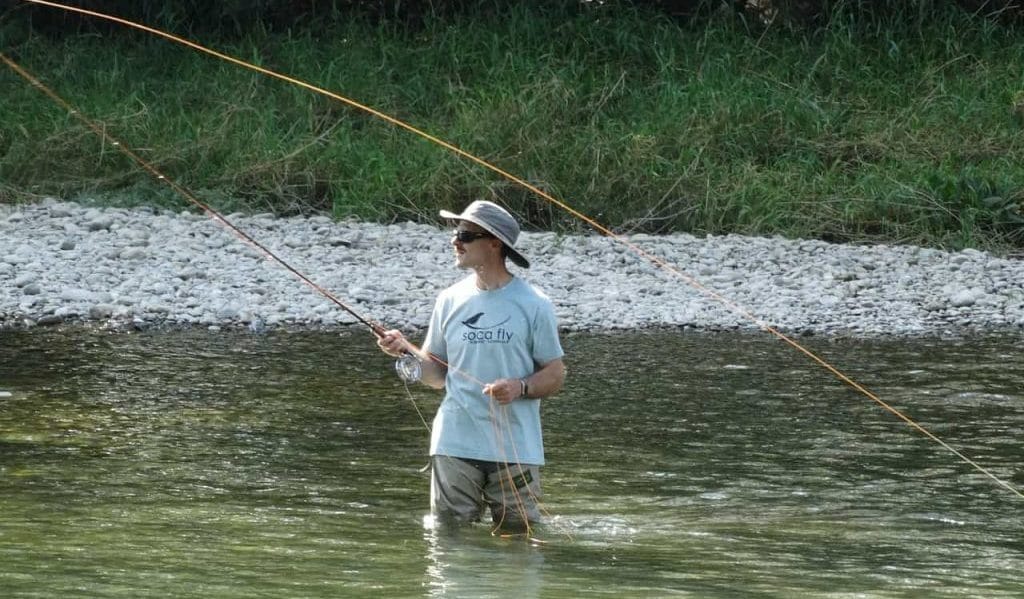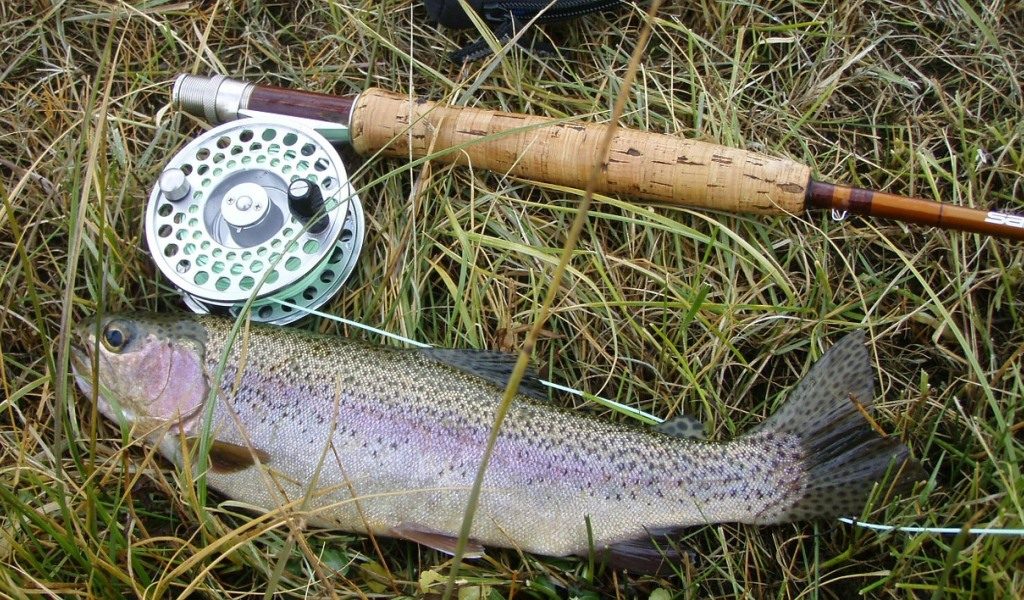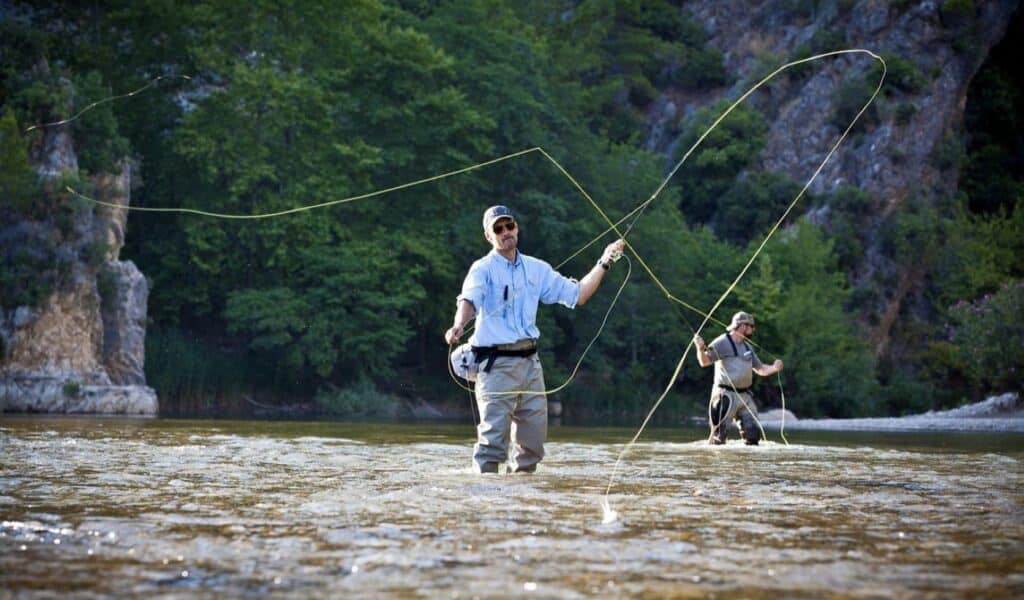Brook Trout Fly Fishing Tips: Welcome to our Brook Trout Fly Fishing guide! In this guide, we have shared many Brook Trout Fly Fishing Tips & Techniques for Beginners.
We hope this guide can get you started with Fly Fishing for Brook Trout and help you learn How to Fly Fish for Brook Trout.
In this guide, you will learn:
- What is Brook Trout
- 7 Facts About Brook Trout
- What do Brook Trout Eat
- Where to Find Brook Trout
- Brook Trout Fly Fishing Gear, Bait and Flies
- Step-by-Step Brook Trout Fly Fishing Technique
- 11 Brook Trout Fly Fishing Tips for Beginners
- Local and State Laws
What is Brook Trout
Brook trout is a small-sized freshwater trout that is native to the eastern parts of North America. But like other fish, it is stocked throughout America because of its popularity. Brook trout need a colder temperature which is why it migrates up and down the water searching for the right habitat and temperature.
Brook Trout has many nicknames because of its appearance. A speckled trout, a spotted trout, a brookie, and a square tail are some of its popular names.
If you are an experienced angler then you would know which equipment and bait to use. You would know which spot to choose for fishing and how to go about the whole procedure.
But if you are doing it for the first time or you are new to this game, you should do research. You should try to get as much information about brook trout and catching brook trout as you can.
7 Facts About Brook Trout
- The scientific name for Brook Trout is “Salvelinus Fontinalis” signifying that the natural habitat is spring water or freshwater.
- It is small compared to other trout, but it is a lively and active fish.
- Brook trout is called a trout but it is a char.
- Brook trout are greenish-brown with yellowish spots on the back.
- It also has red and blue spots at the rear.
- The abdomen and lower fins are pinkish in color.
- It is originally found in the eastern parts of North America but is stocked throughout America.
- The presence of Brook trout is indicative that the water is pure and pollution-free.
- Brook trout spawn in fall or in late summer depending on the temperature of the water.
What do Brook Trout Eat
Brook trout are smaller as compared to other kinds of trout. The size is dependent on the habitat including the food it eats and the temperature of the water it lives in.
The average size of the Brook trout is 10 inches and the average weight is 1 pound. However, as explained before it is dependent on the habitat and food.
Brook trout eat a variety of food including insects even in larvae and pupal form. Aquatic insect-like caddisflies and stoneflies etc. are among the favorites. Land insects like ants, beetles, crickets, etc. are also consumed by trout. Small fish and frogs are included in the brook trout diet as well.
Brook trout have two single rows of strong teeth on the roof of the mouth which is a distinguishing feature as compared to salmon.
Where to Find Brook Trout
Having complete knowledge of the streams and lakes that can provide you with a good game is important. Before deciding on which lake to go to for fishing brook trout, make sure you know whether it is well-stocked or not.
But just knowing and selecting the stream or lake is not enough to be successful. You should also know which part of the stream you should choose a spot for fishing. Obviously, you would want to select the part where you can find the trout easily. And what better place to search than its eating and resting place.
Brook trout need cool, clear water where they can find food easily. Mid-stream boulders, vegetation at the stream bank, wood-covered areas, and areas where a tree or undercut banks provide shade are good spots to find the trout resting. The stream sides where there is vegetation are a good spot for the trout to find food making it a good spot for you.
Brook Trout Fly Fishing Gear
Brook trout are the easiest to catch using fly fishing equipment. The lure is almost weightless and the casting method is different from other methods. A beginner fly rod can be used with a specialized weight line.
Fly fishing for brook trout requires basic equipment and techniques. The equipment is chosen as in the case of any other fish. That is according to the food the fish prefer and the weight of the fish.
Brook trout are not that heavy. So you can use one of the Best Fly Fishing Combos Under 300. The fishing pole which is about 5-6 feet long, will be enough. A thin fishing line with the 4-6-pound test is all that you need depending on the density of the water.
The fly reel you choose will have a big impact on your fishing experience. So it is important to choose the right one. There are many important factors to consider when choosing a fly reel, including price, material, drag system, and arbor size. You need to consider all these factors before buying a fly reel.
We recommend choosing at least a 5-size fly reel with a large arbor. It will help you cast further and land more fish. If you are looking for something cheaper, then we recommend you to check Best Fly Reel Under 100 reviews.
Use a floating line with dry flies to get the attention of brook trout. Ant flies, Mayflies, Caddisfly, and mosquitoes are a few options that can get the results for you.
You will also need small bronze hooks either size 10 or 14. You can use sinkers or bobbers as per your preference. Also, you may need to wade in the water so carry your wading boots along.
You would also need a net and canvas creel to hold the fish once you catch it. A sling pack can help you carry your tackle easily.
Brook Trout Bait
A wide variety of live bait can be used to lure the brook trout. Brook trout eat small aquatic insects to non-aquatic insects. You can use earthworms, mayflies, fly larvae, grasshoppers, wax worms, minnows, crickets, etc. as live baits to lure brook trout. The type of bait used will also define the type of hook you need to use as well.
You can either prepare it at home or buy the bait for fishing. The material used in homemade bait is usually cheese, corn, cereals, marshmallows, etc. The ingredients are processed and made into a dough-like material. Small chunks and balls are made from that dough to be used as bait.
Brook Trout Fly Fishing Tips
- If you are baiting your line for the first time, make sure you pierce once at both ends of the worm or any live bait you want to use.
- When you approach the stream to cast your line, do it carefully and quietly. Avoid casting even your shadow on the water.
- Try not to disturb the environment too much, that will include getting into the water as well. You would not want to scare the fish away.
- Just find a good spot where you can stand on the shore of the stream and cast your line.
- Stay as close to the shore as possible. If you decide to fish further from shore, then use a fishing kayak or a boat as the water may be colder. But don’t go alone.
- When you catch the fish and decide to release it, make sure you handle it with wet hands. This will protect the outer coating of the fish. This coating is for the protection of the fish’s health.
- Spring is the best time for brook trout fishing. During spring, the trout are active and available near the surface. During summer, you might find the weather pleasant but trout move to the deep bottoms of the lakes and streams.
- You should carry a rain jacket and wading gear with you. Taking a life vest and warm clothes might come in handy as well.
- Carry a personal locating device. You might find poor cell phone service in most parts of the fishing area.
- Make sure to pack some food with you as you never know if luck will be with you or not.
- If you decide to keep the fish and cook it there, make sure you have the right equipment for that and know what rules apply.
Brook Trout Fly Fishing Technique
The basic technique is the same as catching other types of fish. If you have selected the correct equipment and bait, then you have done most of the work. Now bait your hook and make sure it is secured to your line.
- Cast your line aiming upstream. This makes your bait drift back to you.
- Casting upstream is beneficial in the case of live bait but if you are using a lure, then you can cast in any direction you want.
- Watch your line vigilantly after casting while waiting for the fish to bite the bait.
- When the line stretches and you have a bite, reel it in quickly but firmly.
- Hold your fly fishing rod straight so that the fish does not hit your face and body.
- If you are fishing in deep water, add split-shot sinkers to your line.
- After catching the brook trout, you need to decide whether you want to keep the fish or release it back.
- If you want to release the trout back into the water, carefully take the fish off the hook and release it back into the water.
- Make sure you release the fish headfirst into the water.
Local and State Laws
Check with the local authorities about the authorized season for fishing. Some lakes allow only catching the fish and releasing it. They do not allow you to keep the fish. Make sure you know this about the lake or stream you choose to fish in.
You will need a proper fishing license and park permit for fishing brook trout. After acquiring it, make sure you carry it with you when you go fishing. Apart from that, you should have proper knowledge about other rules such as any “no-go” areas.
In some states there is a minimum length limit, meaning that if you catch a fish that is shorter than the minimum length, you would have to release it. Similarly, there are some places where there is a daily limit or a maximum limit for catching certain fish. If you happen to catch more than the maximum limit, you will have to release it back.
Summary
Knowing the right time to go, selecting the right spot, and taking the right equipment is very important. Brook trout is lightweight and you will not need any special gear for catching it. Before going brook trout fishing, you must also understand local rules and regulations.
Brook trout eat all kinds of insects and small aquatic animals and that is why you should select the fly accordingly. You need to cast your line and wait for your reward. The decision about whether you want to release the fish back into the water or keep it is yours. But the bottom line is that you will learn a lot about fly fishing and enjoy your day especially if you are doing it for the first time.
I hope you found this article helpful in learning How to Fly Fish For Brook Trout. If you liked the article, please share it with your friends. If you want to share any of your Brook Trout Fly Fishing Tips then let us know via the comments section.
P.S. You can check out some of the top trout fishing rod reviews if you need a rod for your next trout fishing trip. If you are on a budget, then we suggest you check out the spinning rod under 50 reviews to find a top-rated rod without breaking the bank.
Last Updated on May 15, 2025 by Blaine Townsend




